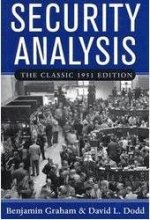Independent Wealth Management
Who scrutinizes your investments, designs and tests your retirement and education plan, searches for new investment ideas, patrols insurance agents and mortgage brokers, shows you strategies designed to reduce your investment costs and income taxes, monitors your 401(k), promptly responds to your email, provides one monthly statement, day-to-day net performance across all of your accounts and does all of your paperwork...We do!
Entries in Investments (20)
Graham and Doddsville

For many years, a popular investing theory has held that the stock market is efficient. In other words, a stock’s price reflects everything that is known about a company, from how the economy is affecting it to how its management is doing. As a result, according to this “efficient market” theory, there can be no overvalued or undervalued stocks. Investors who beat the market year after year are simply lucky, like monkeys flipping coins for bananas.
In his speech—which commemorated the fiftieth anniversary of Security Analysis, a treatise on value investing written by Benjamin Graham and David Dodd—Buffett challenged the efficient market theory by pointing out that a small group of investors have beaten the odds and achieved consistent success in the stock market What did those investors do differently? They all came from the same place...
Incremental Return on Capital
 Although many investors are familiar and comfortable with traditional valuation parameters such as earnings per share (EPS) and return on equity (ROE), these tools may only provide a partially accurate picture of a company’s value. Investors may want to familiarize themselves with another measurement called “incremental return on capital.”
Although many investors are familiar and comfortable with traditional valuation parameters such as earnings per share (EPS) and return on equity (ROE), these tools may only provide a partially accurate picture of a company’s value. Investors may want to familiarize themselves with another measurement called “incremental return on capital.”
Incremental return on capital is a rather interesting figure. Distillation of its meaning essentially leaves you with this definition; a method to assess the return on capital earned on new investments or new dollars. It is a forward leaning analysis of what will likely to occur, based on what has most recently occurred. In many ways this figure is an assumption, a type of financial inertia put in motion by...
Rational Market Expectations
 Noted investor Warren Buffett rarely predicts the future direction of the stock market. He prefers to focus commentary on his trademark investing style, the analysis of corporate valuations. But in 1999, in a series of speeches, Mr. Buffett did cross the prediction threshold—and in the process, provided investing insight that is as relative today as it was 10 years ago. Mr. Buffett reviewed the historical performance of the Dow Jones Industrial Average for the 34-year period that preceded his speech, breaking it into two 17-year segments. His perennial advice? Govern your market expectations carefully.
Noted investor Warren Buffett rarely predicts the future direction of the stock market. He prefers to focus commentary on his trademark investing style, the analysis of corporate valuations. But in 1999, in a series of speeches, Mr. Buffett did cross the prediction threshold—and in the process, provided investing insight that is as relative today as it was 10 years ago. Mr. Buffett reviewed the historical performance of the Dow Jones Industrial Average for the 34-year period that preceded his speech, breaking it into two 17-year segments. His perennial advice? Govern your market expectations carefully.
Segment 1: 1964–1981
During the first 17-year segment, from the end of 1964 through the end of 1981, the Dow Jones Industrial Average (“DJIA”) rose by only 0.88 points, from 874.12 to 875. It wasn’t because...
Margin of Safety
 The world around us has many risks that we cannot control, so we plan accordingly. Essentially, you give yourself some room for error — or a margin of safety in the event something unexpected occurs or your assessment is overly optimistic. In the investment management process, there’s also a margin of safety. While the term may have many different connotations in finance, the most common usage occurs in security analysis, where it refers to the amount by which a security is priced (or “available for purchase”) below its intrinsic value.
The world around us has many risks that we cannot control, so we plan accordingly. Essentially, you give yourself some room for error — or a margin of safety in the event something unexpected occurs or your assessment is overly optimistic. In the investment management process, there’s also a margin of safety. While the term may have many different connotations in finance, the most common usage occurs in security analysis, where it refers to the amount by which a security is priced (or “available for purchase”) below its intrinsic value.
"Price is what you pay -- Value is what you get", said Warren Buffett. Valuing a business is, therefore, a fundamental skill that every value investor must master to be able to discern the intrinsic value of a business. If you’ve already guessed this has something to do with value investing, you’re right. Benjamin Graham, who is often referred to as the father of value investing, first introduced the term in his 1934 book, Security Analysis, which he co-authored with David Dodd. He later revisited it in the much more readable The Intelligent Investor, published in 1949. Today, many well-known value investors, including Warren Buffett (“Berkshire Hathaway”), Mason Hawkins (“Southeastern Asset Management”), Seth Klarman (“The Baupost Group”), Glenn Greenberg (“Chieftain Capital”), Charles Brandes (“Brandes Investment Partners”), Robert Rodriguez (“FPA Capital”) and Joel Greenblatt (“Gotham Capital”) are advocates of the concept.




